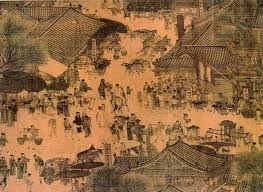|
The Byzantine Empire was founded in 395 A. D., by the two sons of Theodosius the Great, Honorius and Arcadius, when he divided the The Roman Empire. Arcadius was made emperor of Western Europe, but that portion soon passed into the hands of the barbarians. Honorius became ruler of the Byzantine Empire, which existed nearly a thousand years, from the death of Theodosius the Great to the fall of Constantinople in 1453.
The empire was ruled by an Emperor, who held absolute control over the affairs of the government, and was considered a messenger for God. Because of this, the emperors of the empire were figures of key importance, and influenced both directly and indirectly what happened in the empire. Religion also played an important role in the Byzantine Empire, whether in daily life or in government affairs. The empire was a powerful force behind the creation and growth of the Eastern Orthodox Church, as it was adopted as its official religion.

"God-protected" Byzantine society had a strictly hierarchical structure and a centralized authority in accordance with absolutist concepts. The Emperor "by the grace of God" together with his family and court were at the tip of the social pinnacle.
Daily life, profoundly influenced by the commandments of the Christian religion, revolved around the home, in which women devoted themselves to the upbringing of their children, and various public places, where men sought relaxation in their leisure hours.

The upper and middle classes of the empire enjoyed a high standard of living, unmatched in the West until very recent times. Trade and industry prospered. The emperor lived in Oriental luxury and maintained an Oriental ceremonial which emphasized the immense distance between him and his subjects—a ceremonial that impressed even while it excited the verbal derision of western ambassadors from countries that were still little removed from barbarism.
In a society generally considered to be patriarchal and where “patiarchal” often equals “restrictive” some remarkable women’s objects demonstrate quite the opposite that Byzantine women, collectively, engaged in a wide range of activities. The prominence of women in the daily life of the Byzantine Empire strikes with clarity. From traditional activities at home-spinning, weaving, sewing, cooking, tending house to the powerful voices of female rulers and aristocrats, the roles of Byzantine women have never been unimportant.
Byzantine's capital, Constantinople, was built in a key location. It was in the middle the centers of early Christianity and on major trade routes. The city was built by Constantine, Rome's emperor of 330 A.D. Its location gave Constantinople natural protection against any outside forces. It handled rich cargoes from Europe, Asia, and Africa, making it the wealthiest part of the Roman Empire.
Byzantine law was a development of Roman law, frequently codified again after the great Corpus of Justinian and sometimes humanized under Christian influence. This was especially true of the Ecloga of Leo III, perhaps the most humane law code that had been drawn up in history until that time—though it did not prevent the Byzantine rulers from inflicting the most barbarous atrocities upon their political enemies and on prisoners of war when such deeds appeared to be justified by their political purposes.
|

![]()

